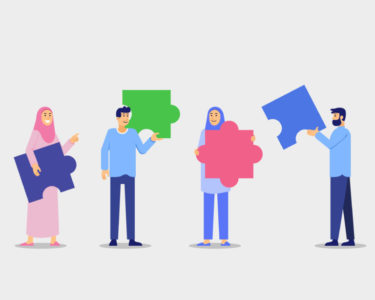Want to hire for more diversity?
Then throw away your culture fit requirement
So you want to start having more Diversity in your team and organizations. How do you do that? Well, you can start by throwing away your culture fit requirements and questions when interviewing candidates for your teams.
Most people think of Diversity and Inclusion at work along typical lines of race, gender, religion, sexual orientation, or abilities. Diversity and inclusion are more than that. Things like neurodiversity or even personality traits like introvert, extrovert, and ambivert go beyond what people typically think of when it comes to Diversity.
You tend to employ very similar people when you hire based on cultural fit (aside from the usual skills). And when you do that, you decrease the potential Diversity on your team. You increase the echo chamber of sameness, similar to what you find on social media with posts that you like, and end up having a very narrow, skewed perspective. Studies have shown that more diverse teams perform better than less diverse teams.

Yes, you most likely will get along better with people similar to you when you have someone who matches your culture fit. However, getting along is only part of the equation for high-performing teams. One of the critical things for high-performing teams is the impact they produce. When you have more diverse opinions on a team, the team has a better chance of coming up with really unique and novel solutions to problems your business is trying to solve.
It does take work when hiring someone who isn’t quite a cultural fit. And I think most people and organizations fail to realize that there is more work to do when hiring for Diversity. Because you now have to ensure that you are inclusive of everyone when you have a diverse group of people. Diversity and inclusion are two different parts of the equation – one without the other will cause problems if your efforts aren’t balanced.
No one ever said that Diversity is easy. Most organizations I know hire for Diversity, but once these people are in the organization, companies fail in providing an inclusive environment. Instead, they constrain people by telling them they need to act or behave a certain way. In the end, you’re only creating Mini Me’s that defeat the benefits of Diversity.
How I Went Against The Grain
Let me give you an example of what I mean. At a start-up I was working in, I was the engineering director, and we were interviewing software engineering candidates. From the skill side of the house, we interviewed one candidate who had ticked all our boxes regarding skill sets.
However, everyone on the interviewing team (including the CEO) had their thumbs down when it came to a decision for hiring this candidate. I was the only one who had a thumbs up. I had asked why everyone had their thumbs down. All responded and said they didn’t think he matched our company culture fit. They felt the candidate didn’t fit the culture because he was more reserved, introverted, and quiet in his demeanor. He didn’t display the high-energy, gung-ho, peppy personality people wanted. They felt he would only keep to himself.
But I saw things differently. I noticed that our candidate had solid engineering practices. Yes, he didn’t fit the culture fit questions – that was very obvious. But I overrode everyone as Director of Engineering and proceeded to hire him. It was my decision to make in the end.
Once I hired him, I made sure that I put in some extra work to be more inclusive of his style in order to incorporate it with the rest of the team’s styles. I put in a little more effort to ensure that our new team member would succeed. And I also suggested to my direct reports (including our new hire) how to slightly modify their approaches to other peoples’ styles.
In the end, my decision to hire against the grain of culture fit paid off. Our new member brought fresh perspectives to problems we were trying to solve. He came up with some very creative approaches that the team had not even thought of or considered. He even managed to mentor some of the more junior engineers.
In the end, my CEO was impressed. He said that I had made a good decision in hiring him despite everyone saying no due to the lack of “cultural fit.” It took this one example to show everyone that hiring for Diversity goes beyond the standard checkboxes of race, gender, creed, or sexual orientation. It took this example to make people realize that hiring for Diversity can be achieved in other ways. And incorporating this expanded view – with the commensurate amount of work – can enable teams and organizations to create more meaningful impacts and outcomes.